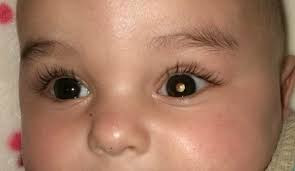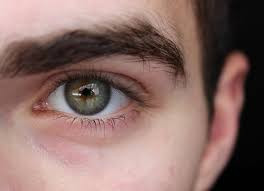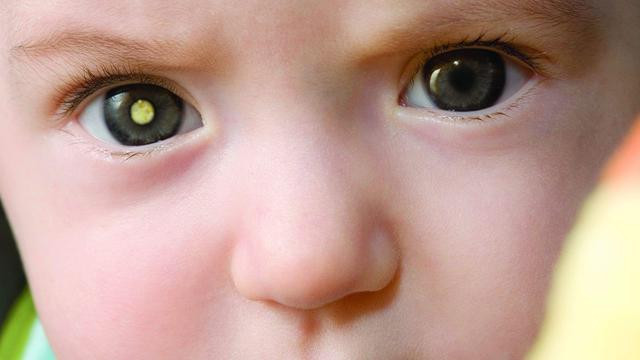Definisi
Retinoblastoma adalah keganasan di dalam bola mata yang paling banyak terjadi pada anak. Dari seluruh tumor yang biasa terjadi pada anak kecil, retinoblastoma menempati urutan ke-3 sebagai tumor mata tersering. Angka kejadian retinoblastoma berkisar antara 1 kejadian per 14.000 bayi yang lahir hidup sampai 1 kejadian per 20.000 bayi yang lahir hidup. Dari semua kasus retinoblastoma sendiri, 90% muncul di bawah usia 3 tahun.
Penyebab
Retinoblastoma terjadi sebagai akibat dari mutasi atau perubahan pada gen bernama RB1. Pada kondisi normal, gen ini berfungsi untuk menekan pertumbuhan sel agar tidak berlebihan. Gen ini diwariskan dari kedua orang tua, dan retinoblastoma baru terjadi apabila kedua gen RB1 ini mengalami mutasi. Mutasi atau perubahan pada gen RB1 ini menyebabkan sel-sel retina (lapisan di dalam bola mata yang berfungsi untuk menerima cahaya) bertambah banyak namun tidak terkontrol.
Mutasi yang terjadi pada gen RB1 dapat merupakan bawaan ataupun terjadi pada saat perkembangan. Jika gen RB1 mengalami mutasi bawaan, mutasi ini dapat diturunkan sehingga risiko retinoblastoma pada keturunannya akan meningkat. Selain itu, mutasi bawaan ini meningkatkan risiko tumor pada bagian tubuh lainnya karena gen ini bermutasi di seluruh sel tubuh. Retinoblastoma sendiri dapat terjadi pada satu ataupun kedua mata.
Faktor Risiko
Kejadian retinoblastoma tidak berbeda tergantung jenis kelamin ataupun ras. Seorang anak diketahui memiliki retinoblastoma sekitar usia 18 bulan. Sekitar 90% dari seluruh kasus retinoblastoma didiagnosis pada usia di bawah 5 tahun. Dari seluruh penderita retinoblastoma, hanya 5% memiliki riwayat keluarga, sedangkan 95% lainnya terjadi secara tidak menentu. Sekitar 90% dari seluruh kasus retinoblastoma terjadi pada satu mata dan tidak dapat diturunkan. Risiko retinoblastoma pada saudara kandung atau keturunan dari penderita adalah 1%.
Gejala
Gejala retinoblastoma yang paling mudah dikenali adalah fenomena mata kucing, yaitu bagian tengah mata berwarna putih saat terkena sinar. Hal ini terjadi karena sel-sel tumor memantulkan sinar yang datang. Gejala lainnya yang sering terjadi adalah mata juling, mata merah disertai nyeri, peradangan pada kelopak mata atau kulit di sekitar mata, adanya benjolan di luar mata, penurunan penglihatan, dan penurunan gerak bola mata.
Diagnosis
Diagnosis retinoblastoma dapat diawali dari pertanyaan mengenai riwayat penyakit pada keluarga. Riwayat keluarga yang dapat berkaitan dengan retinoblastoma adalah riwayat kebutaan, tumor pada mata, penyakit keganasan pada masa kecil, atau riwayat pembedahan pengangkatan bola mata (enukleasi). Selain itu, dokter dapat menanyakan sejak kapan Anda melihat mata anak Anda berwarna putih jika terkena cahaya.
Selanjutnya, dokter dapat melakukan beberapa pemeriksaan langsung. Pemeriksaan dimulai dari pemeriksaan tajam penglihatan sesuai dengan usia, dan hal ini dilakukan pada masing-masing mata. Dokter juga akan menyinarkan cahaya ke mata untuk melihat refleks cahaya pada masing-masing mata. Setelah itu, dokter akan memeriksa bagian luar mata untuk mencari adanya peradangan pada kulit kelopak mata serta kulit di sekitar mata. Kemudian, dokter dapat melakukan pemeriksaan menggunakan slit lamp untuk mencari adanya mata merah, penumpukan nanah pada bola mata, pembuluh darah baru pada selaput pelangi mata, serta tanda glaukoma (kerusakan saraf penglihatan).
Untuk melihat lebih jauh ke dalam bola mata, dokter dapat melakukan pemeriksaan yang disebut sebagai funduskopi. Sebelum pemeriksaan ini dilakukan, anak Anda akan diberikan obat untuk melebarkan pupil (celah hitam pada bagian tengah mata) dan mungkin akan diberikan obat bius agar pemeriksaan dapat dilakukan dengan lebih mendetail. Pemeriksaan ini diperlukan untuk mendiagnosis retinoblastoma, menentukan posisi dan besar tumor, serta menentukan derajat tumor. Pemeriksaan ini dilakukan kepada kedua mata.
Selanjutnya, dokter akan melakukan pemeriksaan pencitraan dengan USG. USG dapat menunjukkan gambaran massa atau tumor pada mata, serta menentukan panjang, lebar, dan tinggi tumor. Selain itu, dokter juga akan melakukan pemeriksaan MRI pada anak, untuk mencari adanya penyebaran tumor ke saraf penglihatan. CT scan tidak disarankan pada anak dengan retinoblastoma, karena paparan radiasi dapat meningkatkan risiko keganasan lainnya jika anak ternyata memiliki mutasi gen RB1 pada sel tubuh.
Pemeriksaan lainnya yang dapat dilakukan adalah pemeriksaan genetik dan jaringan tumor. Pemeriksaan genetik tidak hanya dilakukan kepada anak, tetapi juga kepada orang tua dan saudara kandung anak. Hal ini diperlukan untuk mengetahui apakah retinoblastoma yang dialami anak dapat diturunkan atau tidak. Sementara itu, pemeriksaan jaringan tumor dilakukan untuk mengetahui dari mana jaringan tumor berasal.
Tata Laksana
Tata laksana retinoblastoma melibatkan banyak pihak, yaitu dokter spesialis mata, ahli kanker anak, ahli genetik, dan tenaga kesehatan lainnya, serta orang tua. Terapi yang dapat dilakukan pada retinoblastoma dapat melibatkan beberapa cara:
- Kemoterapi. Kemoterapi merupakan terapi yang paling sering dilakukan pada retinoblastoma. Kemoterapi menggunakan obat-obatan yang berfungsi untuk menghancurkan tumor atau menghambat pertumbuhan tumor. Obat tersebut dapat dimasukkan lewat pembuluh darah atau langsung ke dalam bola mata.
- Transpupillary Thermal Therapy (TTT). TTT menggunakan panas untuk mematikan pembuluh darah yang menyuplai nutrisi pada tumor. TTT dapat digunakan bersamaan dengan kemoterapi atau terpisah.
- Krioterapi. Terapi ini berfungsi untuk membekukan tumor, sehingga jaringan tumor tersebut mati.
- Brakiterapi. Terapi ini dilakukan dengan menempatkan pusat radiasi di dekat bagian tubuh yang memerlukannya, dan bertujuan untuk menghancurkan sel-sel tumor.
- Radioterapi. Terapi ini dapat menjadi pilihan untuk menghancurkan sel tumor, namun penggunaannya harus hati-hati karena dapat memicu keganasan di tempat lain.
- Enukleasi. Enukleasi adalah pembedahan yang bertujuan untuk mengangkat bola mata. Hal ini dilakukan apabila kemoterapi gagal dan berisiko tinggi muncul kembali, atau jika tumor menyerang bagian depan bola mata. Biasanya, setelah dilakukan enukleasi, anak akan menjalani kemoterapi jika masih ada sisa tumor pada jaringan di sekitar mata.
Setelah terapi dilakukan, dokter akan merencanakan kontrol untuk anak Anda. Kontrol ini bertujuan untuk memantau perkembangan tumor serta memantau fungsi penglihatan anak Anda.
Komplikasi
Retinoblastoma jika dibiarkan dapat menimbulkan berbagai komplikasi. Komplikasi tersebut dapat berupa penyebaran tumor ke bagian tubuh lainnya seperti saraf penglihatan, otak, tulang, kelenjar getah bening, serta jaringan lainnya di sekitar mata. Selain itu, komplikasi pada bola mata dapat berupa lepasnya lapisan retina, kematian sel-sel retina, katarak, dan glaukoma. Komplikasi pada penglihatan dapat berupa kebutaan.
Pencegahan
Retinoblastoma tidak dapat dicegah, namun dapat dikenali sejak dini. Jika Anda memiliki anggota keluarga dengan riwayat kebutaan atau tumor pada mata saat kecil, Anda dapat memeriksakan anak Anda ke dokter spesialis mata untuk melakukan skrining retinoblastoma.
Kapan Harus ke Dokter?
Segeralah ke dokter bila Anda melihat mata anak Anda berwarna putih saat terkena cahaya, atau jika anak Anda memiliki mata juling. Kedua gejala ini merupakan gejala tersering retinoblastoma yang dapat pula dikenali oleh orang tua. Kedua gejala ini tidak hanya terjadi pada retinoblastoma, namun dapat pula mengarah kepada kondisi mata lainnya yang perlu ditangani. Retinoblastoma membutuhkan penanganan khusus yang sebaiknya segera dilakukan sebelum tumor menyebar ke tempat lainnya atau sebelum terjadi kebutaan permanen.
Mau tahu informasi seputar penyakit lainnya? Cek di sini, ya!
- dr Nadia Opmalina
Choe, C., O'Brien, J., Phelps, P., Bacal, D., Miller, A., & Epley, K. (2021). Retinoblastoma - EyeWiki. Retrieved 15 November 2021, from https://eyewiki.aao.org/Retinoblastoma
Ishaq, H., & Patel, B. (2021). Retinoblastoma. Retrieved 15 November 2021, from https://www.ncbi.nlm.nih.gov/books/NBK545276/
Isidro, M. (2019). Retinoblastoma: Background, Pathophysiology, Epidemiology. Retrieved 15 November 2021, from https://emedicine.medscape.com/article/1222849-overview#showall












